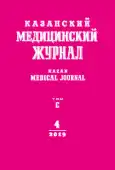Остеометрия позвоночного столба человека зрелого возраста Уральского региона
- Авторы: Меньщикова И.А.1
-
Учреждения:
- Южно-Уральский государственный медицинский университет
- Выпуск: Том 100, № 4 (2019)
- Страницы: 622-628
- Тип: Теоретическая и клиническая медицина
- URL: https://journal-vniispk.ru/kazanmedj/article/view/15529
- DOI: https://doi.org/10.17816/KMJ2019-622
- ID: 15529
Цитировать
Полный текст
Аннотация
Цель. Выявить закономерности изменений остеометрических характеристик позвоночного столба взрослого человека-жителя Уральского региона.
Методы. Исследовали 56 трупов людей зрелого возраста (28 женщин в возрасте от 21 до 55 лет и 28 мужчин в возрасте от 22 до 60 лет) — жителей Уральского региона. Для распределения материала по возрастным группам была использована схема, рекомендованная симпозиумом по возрастной периодизации в Институте возрастной физиологии в 1969 г. Применяли остеометрический и статистический методы.
Результаты. В шейном отделе наибольший сагиттальный размер определяли у остистого отростка VII шейного позвонка (30,9±1,79 мм), в грудном отделе — у VII грудного позвонка (41,5±2,4 мм), в поясничном — у III поясничного позвонка (36,4±0,95 мм). Фронтальный размер тел позвонков увеличивался от выше- к нижележащим позвонкам, но от I грудного до VI грудного позвонка зарегистрировано снижение фронтального размера тел позвонков, а начиная с уровня VII грудного позвонка — дальнейшее его увеличение. Сагиттальный размер тела позвонка увеличивался только от II шейного до III поясничного позвонка. Сагиттальный размер тел III–V поясничных позвонков был в диапазоне от 32 до 34 мм. Размеры ножки дуги позвонка позволяют проводить транспедикулярную фиксацию на уровне всех позвонков, но необходимо учитывать, что у V и VI грудных позвонков фронтальные размеры ножки дуги наименьшие по сравнению с другими уровнями. Фронтальные размеры позвоночного канала больше, чем сагиттальные, на уровнях всех позвонков, за исключением атланта и V грудного позвонка.
Вывод. Результаты могут служить базисом при проведении любых оперативных вмешательств на позвоночном столбе и выступать в качестве нормы для оценки его патологических изменений.
Ключевые слова
Полный текст
Открыть статью на сайте журналаОб авторах
Ирина Анатольевна Меньщикова
Южно-Уральский государственный медицинский университет
Автор, ответственный за переписку.
Email: iamen@mail.ru
г. Челябинск, Россия
Список литературы
- Гайворонский И.В., Мануковский В.А., Кац А.В. Морфометрические характеристики поясничных позвонков взрослого человека и возможность прогнозирования объёма их тела при чрескожной вертебропластике. Морфология. 2009; 136 (5): 67–72. PMID: 20210101.
- Гладков А.В., Комиссаров В.В. Морфометрия как первый шаг по пути моделирования двигательного сегмента позвоночника. Вестн. Сибирского ун-та потребительской кооперации. 2015; (2): 93–102.
- Островский В.В., Нинель В.Г., Анисимова Е.А. Морфометрическое обоснование использования вентральной фиксации при хирургической реабилитации пациентов с подаксиальными повреждениями шейного отдела позвоночника. Саратовский науч.-мед. ж. 2009; 5 (1): 100–103.
- Oura P., Korpinen N., Niinimäki J. et al. Estimation of stature from dimensions of the fourth lumbar vertebra in contemporary middle-aged Finns. Forensic Sci. Intern. 2018; 292: 71–77. doi: 10.1016/j.forsciint.2018.09.001.
- Ji G.Y., Oh C.H., Park S.H. et al. Feasibility of translaminar screw placement in Korean population: morphometric analysis of cervical spine. Yonsei Med. J. 2015; 56 (1): 159–166. doi: 10.3349/ymj.2015.56.1.159.
- Srivastava A., Nanda G., Mahajan R. et al. Feasibility of sub-axial cervical laminar screws, including C7, in the Indian population: A study on 50 patients using computed tomography-based morphometry measurements. Asian Spine J. 2018; 18: 132–135. doi: 10.31616/asj.2018.0110.
- Chazono M., Tanaka T., Kumagae Y. et al. Ethnic differences in pedicle and bony spinal canal dimensions calculated from computed tomography of the cervical spine: a review of the English-language literature. Eur. Spine J. 2012; 21 (8): 1451–1458. doi: 10.1007/s00586-012-2295-y.
- Семёнова Л.К. Исследования по возрастной морфологии за последние пять лет и перспектива их развития. Арх. анатомии, гистол. и эмбриол. 1986; (11): 80–85.
- Алейник А.Я., Млявых С.Г., Боков А.Е. Транспедикулярная фиксация в шейном отделе позвоночника: обзор литературы и клинические данные. Хирургия позвоночника. 2017; 14 (3): 47–53. doi: 10.14531/ss2017.3.47-53.
- Афаунов А.А., Кузменков А.В. Транспедикулярная фиксация при повреждениях грудного и поясничного отделов позвоночника, сопровождающихся травматическим стенозом позвоночного канала. Хирургия позвоночника. 2011; (4): 8–17. doi: 10.14531/ss2011.4.8-17.
- Привес М.Г., Лысенков Н.К., Бушкович В.И. Анатомия человека. Учебник. СПб: СПб МАПО. 2017; 720 с.
- Scoles P.V., Linton A.E., Latimer B. Vertebral body and posterior element morphology: the normal spine in middle life. Spine. 1988; 13 (10): 1082–1086. PMID: 3206263.
- Pierro A., Cilla S., Maselli G. et al. Sagittal normal limits of lumbosacral spine in a large adult population: A quantitative magnetic resonance imaging analysis. J. Clin. Imaging Sci. 2017; (7): 35. doi: 10.4103/jcis.JCIS_24_17.
Дополнительные файлы










